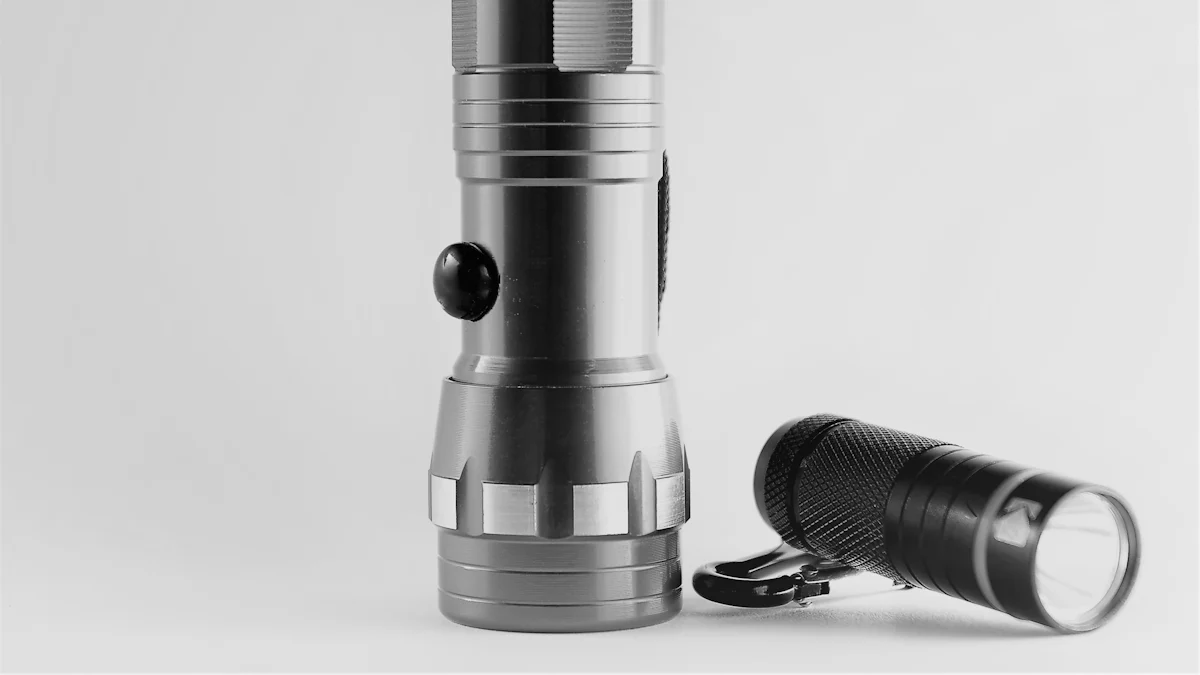Unveiling the Key Differences Between Flashlights and Tactical Flashlights

Understanding the difference between a regular flashlight and a tactical flashlight is crucial in selecting the right tool for various needs. In this blog, we will delve into the distinct features that set these two types of flashlights apart. From brightness levels to durability and specific use cases, we aim to provide a comprehensive comparison. By focusing on brightness, durability, and use cases, we will shed light on how each type serves different purposes effectively.
Difference in Brightness

Brightness Levels
When comparing the brightness levels of a regular flashlight to a tactical flashlight, it's evident that tactical flashlights outshine their regular counterparts. Regular flashlights typically have lower brightness levels compared to tactical flashlights. Tactical flashlights with 1000-3000 lumens are considered ideal for hunters, security guards, and law enforcement personnel due to their powerful brightness and long-distance visibility.
Regular Flashlight Brightness
Regular flashlights usually offer standard brightness suitable for everyday tasks like navigating dark spaces or finding lost items indoors. However, their limited lumens may not suffice for outdoor activities or emergency situations that demand high visibility.
Tactical Flashlight Brightness
On the other hand, tactical flashlights boast exceptional brightness levels ranging from 1000 to 3000 lumens, ensuring optimal illumination in various scenarios. The intense light output of these flashlights makes them indispensable tools for professionals in law enforcement and security fields.
Range of Illumination
Apart from brightness, another crucial aspect where tactical flashlights excel is the range of illumination they provide compared to regular flashlights.
Regular Flashlight Range
Regular flashlights typically offer a limited range of illumination suitable for short-distance tasks. Their beam may not extend far enough to illuminate objects at a distance effectively, making them less versatile in outdoor settings.
Tactical Flashlight Range
In contrast, tactical flashlights are designed with an extended range of illumination that can reach up to 500 meters or more. This feature proves invaluable in scenarios where long-distance visibility is essential, such as search and rescue operations or outdoor recreational activities like camping and hiking.
Difference in Durability

When considering the difference between a standard flashlight and a tactical flashlight, one crucial aspect to examine is their durability, which plays a significant role in their effectiveness for various applications.
Material and Build
In terms of material composition and construction, regular flashlights are typically crafted using standard materials like plastic or basic metals. These materials provide adequate durability for everyday use but may not withstand more demanding situations that require robustness and resilience. On the other hand, tactical flashlights are engineered with specialized materials such as aircraft-grade aluminum or reinforced polymers. These high-quality components ensure superior strength and longevity, making tactical flashlights well-suited for rugged environments and intense activities.
Regular Flashlight Materials
Plastic
Basic Metals
Tactical Flashlight Materials
Aircraft-grade Aluminum
Reinforced Polymers
Weather and Shock Resistance
Another critical factor distinguishing regular flashlights from tactical ones is their resistance to external elements and impacts.
Regular Flashlight Resistance
Standard flashlights often lack sufficient protection against harsh weather conditions or accidental drops. Their limited resistance makes them less reliable in outdoor settings where exposure to moisture, dust, or rough handling is common.
Tactical Flashlight Resistance
In contrast, tactical flashlights are designed to be weather-resistant and shockproof. These features ensure that the flashlight remains operational even in challenging environments such as heavy rain or rough terrains. The ability to withstand shocks enhances the reliability of tactical flashlights during intense activities like hiking, camping, or emergency situations.
By understanding the distinct differences in durability between regular flashlights and tactical counterparts, users can make informed decisions based on their specific needs and usage requirements.
Difference in Use Cases
Everyday Use
When considering the difference between a standard flashlight and a tactical flashlight, it is essential to examine their distinct applications in everyday scenarios.
Regular Flashlight Uses
Illuminating dark areas during power outages
Finding lost items in the house
Providing light for evening walks or jogs
Assisting with car repairs in dimly lit spaces
Tactical Flashlight Uses
Enhancing visibility during nighttime outdoor activities like camping or hiking
Inspecting surroundings for potential threats or dangers
Signaling for help in emergency situations
Safeguarding personal safety while walking alone at night
Professional and Emergency Use
In professional settings and emergency situations, the disparity between regular flashlights and tactical flashlights becomes even more pronounced.
Law Enforcement and Military
Supporting law enforcement officers during nighttime patrols
Aiding military personnel in tactical operations and maneuvers
Illuminating large areas for search and rescue missions
Disorienting suspects or enemies with intense brightness
Self-Defense and Extreme Situations
Acting as a non-lethal self-defense tool by disorienting attackers with bright light
Providing temporary blindness to adversaries for escape opportunities
Facilitating navigation through challenging terrains during emergencies
Ensuring visibility in extreme weather conditions for survival purposes
Recapping the highlighted disparities between regular flashlights and tactical counterparts reveals crucial variances in brightness, durability, and intended applications. Choosing the appropriate flashlight tailored to specific needs is paramount for optimal performance. For future considerations, advancements in materials and illumination technologies could enhance the functionality of these essential tools. Selecting a reliable flashlight ensures efficiency in various scenarios, as evidenced by users' testimonials praising the durability and effectiveness of these indispensable devices.
2024/6/7
See Also
Exploring the Meaning of a Tactical Flashlight
Contrasting Diving Flashlights with Standard Flashlights
Exploring Various Kinds of Flashlights
Law Enforcement Flashlight vs Standard Flashlight: Which Prevails?
Contrasting Green Light Flashlights with White Light Flashlights for Hunting
